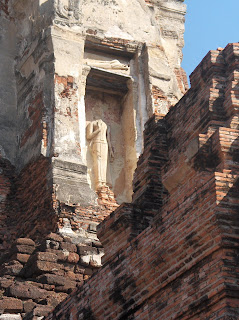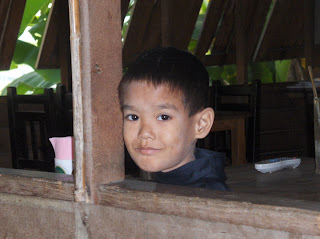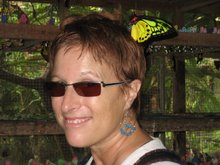The Fertile Mekong Delta

We traveled the six-hour journey from Siem Reap to Phnom Penh by bus, taking rest stops along the way for food from stall shops and lovely squat toilet-age. At one rest stop, a woman was selling fried spiders. Try some! ~

It's never easy for me to say no to beggars and it's harder still, in Cambodia, having some idea about why they often have no education or limbs missing. (Add national guilt knowing it all started with US bombing along their eastern border towns....) The general wisdom with beggars is not to encourage begging by giving them money; finding a reliable non-profit is advised. Also, especially with children, they often have to hand money over to someone else. So it's better to give food. But the dilemma there is you give to one and the rest come running. And then sometimes you just have to do it anyway. That day, at one rest stop, after I had said no, sorry, to a number of people, a bedraggled woman carrying a dirty, naked baby, and with two other moppets in tow, approached me and Eric with her hand out. Initially we said no, but she didn't walk away. She and the moppets stood close together with us, as a group, and I had the sensation/remembrance that this was my family. What I do mostly with my family is feed them. I couldn't not do this. So I went to a nearby stall and purchased two peeled pineapples and four hard-boiled eggs (using up my remaining riel; the merchant wouldn't take USD), and handed them to the mother. She looked deep into my eyes, thanking me profusely, and we bowed back and forth. As I walked away, a man on crutches, missing one leg, smiled big and motioned in appreciation for what I'd done for the previous family, and then pointed gently toward his young son. I was out of riels, the bus was getting ready to leave, and I again had to say no, sorry. My heart broke. When we left, I saw the woman sharing what she had with the man and his son.
Our entry into Phnom Penh was made delightful by meeting friends for dinner at the venerable Foreign Correspondents' Club. Eric's work buddy, Rob, and his fiance Holly, are living in Phnom Penh for a few months. As with us, they are taking time away from work; their approach is to pick a few places and live there for some months. Holly is even volunteering for a non-profit--cool way to get involved and understand the life there.
Phnom Penh From the Foreign Correspondents' Club Terrace


Phnom Penh is Cambodia's capital. Along with Saigon, it was a US headquarters during the American/Cambodian/Vietnamese wars. As other cities and villages were being demolished, Phnom Penh became a (pathetically ill-equipped) refugee center. Shortly after the US pulled out of Phnom Penh, the Khmer Rouge overtook the city, eventually evacuating all of its inhabitants to be tortured, executed, or work in the fields. Because of this, Phnom Penh was virtually empty for a number of years. (I am currently reading Sideshow: Nixon, Kissinger, and the Destruction of Cambodia by William Shawcross. It is well documented and offers good historical and background information into these events. Some of the inane quotes from our (US) leaders during that time and other events sound similar to that of some of our current leaders, or like they were written for Saturday Night Live. And some of the parallels with the war in Iraq, such as Nixon's cowboy stance after watching Patton three times, and his determination to make a big last-ditch troop surge to save face and show that a third-world country can't beat the US, is tragically ironic.) More horrible still, Phnom Penh is the site of the Killing Fields and Toul Sleng Museum (Security Prison, S-21), the largest torture and extermination camps during the Khmer Rouge regime.
Victims were first interrogated and tortured at S-21, then brought by truck to the Killing Fields. Words can't convey my experience when we went to the Killing Fields and S-21, but I'll try. We traveled first by tuk tuk 15 dust-filled kilometers out of the city into pretty farmland of rice paddies, pastures, longan and palm trees, to the Killing Fields. The first stop is the Charnel House, a monument to those who died there. It is a tall, glass building, filled to the top with shelves containing torture implements, the skulls of beheaded victims, and their clothing. Visitors are asked to offer a stick of incense and a prayer for the victims and their families before entering. Eric and I did so. I also sent Reiki to them, for peace. While Reiki practice always feels worthwhile, in this case I felt like I was lighting a match against a glacier.
The Charnal House


The fields contained a bunch of holes where hundreds of people where thrown after they were killed.
The Killing Fields

People were sometimes shot; they were also bludgeoned to death with bamboo poles, sharpened sticks and walking canes, hoes, whatever, to save bullets. Once in the pit, they were covered with DDT to quell the stench and hasten death if it hadn't occurred already. There was also the Magic Tree, where a loudspeaker hung to play music to cover the victims' screams, as well as the Happy Tree, against which infants and small children were thrashed until they died. Children were also sometimes torn apart limb from limb. All around the fields, snatches of old clothing still lay. My hands burned from the energy of the area, which was horribly oppressive and depressing.
S-21 was originally a high school, where the classrooms were partitioned with brick or wooden walls to form cells where prisoners lay chained. The irony of this place is in its initially apparent normalcy; from outside it looks like any high school, white, with a few wings, three stories each, flowering trees, grass, and benches. The interior is painted a cheery mustard yellow, with mustard yellow and white checkered floors. That is where the cheer ends. The rooms that don't contain cells are filled with rows and rows of pictures of the thousands of Cambodians from infancy through adulthood who were imprisoned and tortured here before being sent to the Killing Fields. (Out of ~9000 victims, only 7 from S-21 survived.) Rooms without cells displayed victim and Khmer Rouge portraits and actual torture devices.
S-21 Torture Camp and Genocide Museum

Prisoner Cells

The horrible, sickly, cloying feeling that had been swirling around me felt like it was seeping into by bones when I stepped into one of the smaller cells. I imagined myself and my family going through what these people went through. I also felt strange feeling so bad, like I had no right, since it wasn't us. I was just bumbling my way through someone else's history. Still, it felt like their was no air and I could only remain in there a few moments, then all energy left me, and I started feeling very fatigued. I felt worse and worse the rest of the day, then got feverish and body aches. This all turned into an intestinal flu within a day and I was down for a few more. For days after, I kept imagining people I saw on buses and in the streets being imprisoned like this, or carrying out this horrid mandate.
Victims
This picture held extra poignancy for me as the teenagers in these photos and the high school girls are about the same age, as was I around the time this happened. I remember hearing about the news about Vietnam and being sad and angry, but the extent of my involvement had only been to wear a Vietnam vet's MIA bracelet until he was found two years later. I really had no clue.

This woman holds her baby as their picture is taken. Standing close to the actual picture, you can see tears welling up in the mother's eyes. Prisoners were not allowed to cry, on pain of being beaten or electrocuted.

The last room I visited held current and earlier pictures and statements from some Khmer Rouge who worked at S-21. Their current pictures showed them happy and smiling, with family, working their farms or in their shops, or fishing. Some statements sounded sad but not terribly regretful for what they did. They made claims such as that the Khmer Rouge was better than the existing government, that once they joined they could not leave or they and their families would be killed, and that the people who should be punished are the leaders, not the soldiers who carried out the orders.
Seeing this was the nightmare you want to end, to make it have not happened to these people, to awaken by just opening your eyes wide, only you do and see that it isn't a nightmare, and nothing can change what happened.
To carry out such sickness, and as a society we seem to never learn, one has to create an Other and then dehumanize him or her. We do that on so many levels, carrying out violence large and small over territory, politics, business, and our relationships with ourselves, and those around us. We use war symbology in business and play that makes the extension of such seem less evil. For example, I was once in a meeting where a PowerPoint presentation was being presented to the group before being put on the intranet for internal salespeople's use. The presentation featured a video of real bomber planes letting loose their payload, complete with sound as the bombs hit. This was what we wanted to do to our competition. The presenter thought it was so cool he replayed the video. I did what I often do when affronted by the ludicrous--I laughed maniacally, then objected and was made fun of by a couple of the men in the room. Later, to see if it was just me or if that was really dysfunctional, I ran it by a few other people, including two who I knew had grown up with bombings during their childhoods in Lebanon. They all thought it was sick and were thoroughly disgusted.
There is a poster in the Saigon (Ho Chi Minh City), Vietnam airport, a woman under a white parasol by a palm-lined stream, that says "Look at us now."
What can we do now? Violence is anything that diminishes oneself, another being, or the environment. Our little acts of violence, the ones we call No Big Deal, can breed the insensitivity that causes other acts of violence, large and small. Going through S-21 and the Killing Fields was a reminder that the Other is also me and those I hold dearest, and to be mindful when my actions or words could cause or contribute to unnecessary harm. Few people can be perfect at this, but if everyone made it their practice, I think it would be a better world.
All beings tremble before violence.
All fear death.
All love life.
See yourself in others.
Then whom can you hurt?
What harm can you do?
... Do not make light of your failings,
Saying, "What are they to me?"
A jug fills drop by drop.
So the fool becomes brimful of folly.
Do not belittle your virtues,
Saying, "They are nothing."
A jug fills drop by drop.
So the wise man becomes brimful of virtue.
~ Buddha, as translated by Thomas Byrom in The Dhammapada: Sayings of the Buddha
"You must be the change you wish to see in the world."
~ Mahatma Gandhi







 In a cruel twist of cookie karma, Sheila would later discover there was in fact no juicy strawberry creme filling whatsoever between the biscuits.
In a cruel twist of cookie karma, Sheila would later discover there was in fact no juicy strawberry creme filling whatsoever between the biscuits.



























 The horrible, sickly, cloying feeling that had been swirling around me felt like it was seeping into by bones when I stepped into one of the smaller cells. I imagined myself and my family going through what these people went through. I also felt strange feeling so bad, like I had no right, since it wasn't us. I was just bumbling my way through someone else's history. Still, it felt like their was no air and I could only remain in there a few moments, then all energy left me, and I started feeling very fatigued. I felt worse and worse the rest of the day, then got feverish and body aches. This all turned into an intestinal flu within a day and I was down for a few more. For days after, I kept imagining people I saw on buses and in the streets being imprisoned like this, or carrying out this horrid mandate.
The horrible, sickly, cloying feeling that had been swirling around me felt like it was seeping into by bones when I stepped into one of the smaller cells. I imagined myself and my family going through what these people went through. I also felt strange feeling so bad, like I had no right, since it wasn't us. I was just bumbling my way through someone else's history. Still, it felt like their was no air and I could only remain in there a few moments, then all energy left me, and I started feeling very fatigued. I felt worse and worse the rest of the day, then got feverish and body aches. This all turned into an intestinal flu within a day and I was down for a few more. For days after, I kept imagining people I saw on buses and in the streets being imprisoned like this, or carrying out this horrid mandate.

































